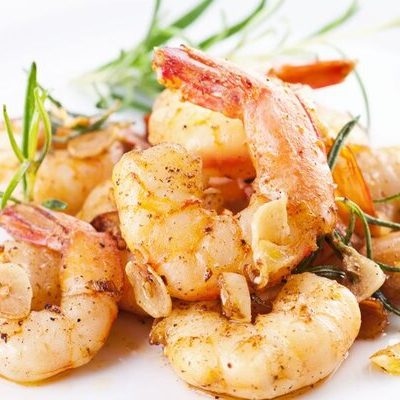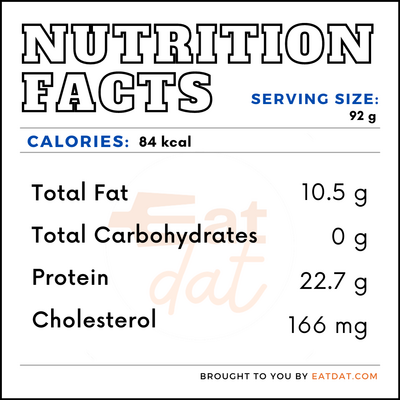
Shrimp
What are Shrimp?
Shrimp are crustaceans with long bodies, tails, slender legs, and whiskers that belong to the Decapoda family. They are a type of seafood, specifically shellfish, that is eaten worldwide. They are closely related to prawns, although this term is mostly used for freshwater varieties.
- There are over 128 varieties of this shellfish.
- This seafood is one of the most consumed types of seafood in the US with Americans eating over one billion pounds of it every year.
Some common varieties of this seafood are:
- Farmed Whiteleg
- Banded Coral
- Brown
- White
- Pink
- Royal Red
- Giant Tiger
- Blue
- Ocean
Origin of shrimp
This shellfish dates back millennia with ancient texts indicating that the Greeks and Romans enjoyed cooking this into dishes. Cookbooks from the 4th and 5th centuries also included recipes for this food. Nonetheless, farming is believed to have started in Asia centuries ago when wild shrimp fry migrated into the area. Modern farming can be traced to Japan in the 1930s, where the first breakthroughs in technology began. Today, this seafood remains one of the most popular types of seafood around the world.
Function
Whether you’re working with small or jumbo-sizes, there’s a world of opportunities for this delicious shellfish. This food makes a great accompaniment to pasta and rice dishes. It’s also possible to sauté, grill, bread, fry, bake, broil, and brine shrimp. Additionally, you can toss it in tacos, sandwiches, kebabs, soups, and curries.
Nutrition
This is a type of shellfish that is low in calories but rich in nutrients. Around 90% of its calories come purely from protein. An 85 g serving of shrimp contains:

This small animal can also offer Selenium, Vitamin B12, Iron, Phosphorus, Niacin, Zinc and Magnesium. Some health benefits associated with this type of seafood are reduced inflammation and improved heart health. Shrimp is also full of an antioxidant known as astaxanthin, which can help combat free radicals and reduce the risk of several chronic diseases. However, this shellfish is high in cholesterol, which may be problematic for individuals who are sensitive to dietary cholesterol. Furthermore, this food may not be suitable for anyone with shellfish allergies. Not to mention that the high demand for this seafood has led to its importation from abroad, where antibiotics may be used in farm-raised varieties.
Commercial Production
Commercial farming first begins with designing a pond that has the right conditions, usually with loam-based soil. Then, the water and soil should be conditioned and any excess waste removed before growing this shellfish. Once the pond is ready, seeds of the selected species are brought in from a hatchery. Growing shrimp requires regular feeding, water management, and stocking density oversight to ensure a healthy and plentiful crop. On average, the culture period for this shellfish is anywhere between 120-150 days.
Farmers have two methods of harvesting: netting or hand-picking. Freshly harvested shellfish must be kept on crushed ice to keep it fresh while packaging and transporting to market. Harvesting time is usually determined by market price and the condition of the pond, as the window for sale is narrow after the this leaves the farm. Furthermore, there are many issues that farmers face, including disease, genetics, pollution, antibiotics, biodiversity loss, as well as their personal wellness. Farming is closely monitored by a variety of government and non-profit environmental agencies around the globe.
Application
This type of shellfish is incredibly popular with seafood lovers around the world. However, there are many points to take into consideration when buying and cooking this seafood. If you plan to purchase this food from a seafood counter, always inspect the quality of the other items and note any foul smells, as well as black spots or markings on the seafood. These are key indicators of age, meaning you should steer clear. You can choose to buy fresh or frozen, although depending on your location, you may not have much choice.
Once you’ve selected your shrimp, it’s vital to store it properly. If it’s fresh, keep it in the coldest part of the refrigerator and use it within two days. Otherwise, you can store it in the freezer. Frozen products should be thawed out in the refrigerator and can be done so overnight. Be sure to give it room to breathe and keep it from becoming pungent by opening its plastic packaging and laying a damp paper towel on top.
Shrimp recipes
This seafood lends itself to a variety of hot and cold dishes. Here are some popular recipes:
- Shrimp Cocktail
- Seafood Paella
- Spaghetti Allo Scoglio
- Shrimp Salad
- Shrimp Scampi
- Creamy Shrimp Croquettes
FDA Regulation
The Food & Drug Administration has standards of identity for raw, canned, and breaded shrimp, as well as cocktails. The organization also provides the recommended reference amounts and label statements for this type of seafood. Furthermore, the FDA has guidelines for selecting and serving this seafood safely to avoid foodborne illnesses. The organization also offers food safety tips for mothers-to-be when preparing this food.
References
“Shrimp Hits Record High Levels of Consumption in United States.” Shrimpalliance.com, Southern Shrimp Alliance, 13 Dec. 2018, www.shrimpalliance.com/shrimp-hits-record-high-levels-of-consumption-in-united-states/.
Chamberlain, George W. “History of Shrimp Farming .” Aquaculturealliance.org, Global Aquaculture Alliance, 23 Oct. 2018, www.aquaculturealliance.org/advocate/history-of-shrimp-farming/.
Elliott, Brianna. “Is Shrimp Healthy?” Healthline, Healthline, 16 Feb. 2018, www.healthline.com/nutrition/is-shrimp-healthy.
Reddy, Jagdish. “Shrimp Cultivation, Shrimp Culture, Harvesting Methods.” Agri Farming, Agri Farming, 18 June 2019, www.agrifarming.in/shrimp-cultivation.
